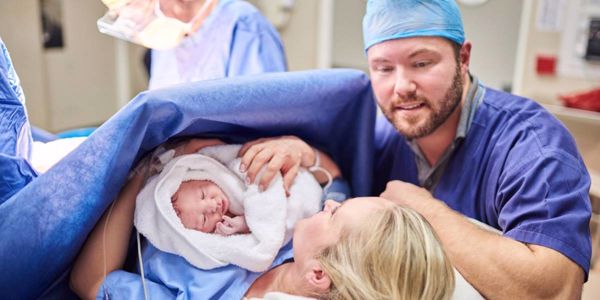Fetal Macrosomia is when a baby is born at a much higher birth weight than average. Babies who are considered to have Macrosomia are born at 8lbs 13oz or more, which only occurs about 9% worldwide. In many cases, individuals can birth “big babies” vaginally, but in some cases, a cesarean section might want to be considered.
The first thing that I want to note is that ultrasound technology is generally incorrect when it comes to measurements of a fetus. Typically, they seem to overestimate or underestimate by close to 10-20%. When getting an ultrasound to measure your baby’s size, don’t stress too much about whether your baby is measuring big or small. My best advice is to have a care provider measure from the top of your pubic bone to the top of your fundus and see if those dates are off, too. If they are not, continue as planned. If they are, getting a second opinion from another ultrasound could be a good idea.
The Risks of Fetal Macrosomia
If your baby truly has Macrosomia, then there are some things to consider. The most common impacts of Fetal Macrosomia are, first, damage and tearing to the birth canal, genital tract, and perineum. Larger babies can cause more invasive tearing and trauma to the tissues in some cases, although I have watched a woman birth an 11lb 8oz baby without a single tear, so it can be done. Another thing that can commonly occur is a heavier postpartum bleed and, in some cases, a hemorrhage. This occurs because the uterus gets more stretched out with a giant baby and, therefore, must work harder to shrink back down in size, causing more bleeding than typical. Because it takes a lot more shifting of bones and work from the body to move a big baby down and out, labor can take quite a bit longer. When dealing with a longer than anticipated labor or labor that seems to plateau, Macrosomia always comes to a care provider's mind.
In some cases, a baby with Macrosomia will have more heart decelerations in labor simply due to the stress of moving through such a small space. These dips can lead to cesarean sections, so it is important to take note of them having a higher chance of occurring. A less common side effect, but a very serious and sometimes deadly one, is uterine rupture.
One thing that most care providers anticipate with suspected big babies is the possibility of shoulder dystocia. This occurs when the shoulders get stuck in the birthing canal, and the care provider needs to do different maneuvers to get the baby unstuck and able to be born. Shoulder dystocia comes with its own set of possible side effects, including bone fractures, brachial plexus injuries, brain damage, need for resuscitation, and postpartum hemorrhage. During the postpartum period, babies who have Fetal Macrosomia are also more likely to have issues with jaundice, low blood sugars, and breathing problems, so keeping an extra close eye is important.
The Causes of Fetal Macrosomia
Some individuals simply make big babies. Two of my three would be considered to have had Fetal Macrosomia, and I know of other parents who seem to make larger babies than normal. With that said, some things can cause larger babies. The leading cause of big babies is Gestational Diabetes, which goes uncontrolled for too long. Obesity and excessive weight gain are two other things that could lead to a baby with Fetal Macrosomia.
Some signs that you might have a baby with Fetal Macrosomia include:
- Having a large fundal height. Anywhere within 2cm on either side can be normal for fetal growth, but outside of that 2 cm should be looked into.
- Excessive weight gain in pregnancy. This is not always the case, but it could be why someone gains more weight than anticipated in pregnancy.
- Having diabetes or uncontrolled gestational diabetes.
- Having a history of large babies. It might just be how you make them!
- Being over one’s due date. We do not give birth by numbers, but it makes sense that the longer you are growing a baby, the bigger your baby might be.
- If you were a big baby yourself, you are more likely to grow a big baby, too. Who knows, it might run in the family!
You know what is best, like anything in childbirth, pregnancy, and postpartum.
Listen to your gut, and trust that it knows what is best. Often, a second opinion is the way to go and will give you the best results and answers. Each baby grows differently, at their own pace, and on their timeline. Trust the process and seek out medical help whenever it is needed.







